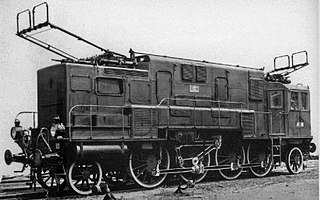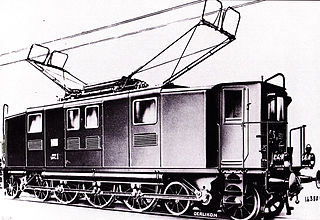Collection
The museum owns a large collection of industrial machines, mechanical parts, products, advertising, related to the vast complex of industrial plants working in Saronno, a little commercial town which developed a large manufacturing sector since the second half of 19th century. The collection includes items from metal-mechanic industries (i.e. Isotta Fraschini, Caproni), food industry (Lazzaroni), electronics (Phonola), textiles, typography. The museum owns also a collection of items and railway stock from Ferrovie Nord Milano, including an electric locomotive, an EMU, a 1930-passenger car, a Saxby interlocking, Edmondson tickets: as far as 1942 the city hosted the large workshop of Ferrovie Nord Milano for steam locomotives maintenance.
Rescaldina is a comune (municipality) that is part of the Metropolitan City of Milan, in the Province of Milan in the Italian region Lombardy, with a population of 14,211 distributed over about 8 km2, and located about 25 kilometres (16 mi) northwest of Milan.

The National Railway Museum of Pietrarsa is close to the Naples–Portici railway.

The Italian railway system is one of the most important parts of the infrastructure of Italy, with a total length of 24,227 km (15,054 mi) as of 2011.

The FS E.625 and E.626 are two classes of Italian electric locomotives produced for the Ferrovie dello Stato. They were introduced in the course of the 1920s and remained in service until the 1990s. The E.626 was the first locomotive fed by 3,000 V DC overhead line in Italy.
Giuseppe Bianchi was an Italian railway engineer on the Ferrovie dello Stato between 1913 and 1946.

Ferrovie Nord Milano is an Italian public transport company: the second largest railway company in Italy. It operates primarily in the northern Italian regions of Lombardy and Piedmont and in Canton Ticino in southern Switzerland. Listed on the Borsa Italiana, its main shareholders are the Lombardy Region (57.57%), Ferrovie dello Stato (14.5%) and Aurelia S.p.A. (3%).

Most railway stations in Italy are maintained and operated by RFI, a subsidiary of Ferrovie dello Stato Group. A minor part of them are operated by private and regional companies, conceded by the state.

The Asturias Railway Museum or Gijón Railway museum, in Gijón, Asturias, Spain, is an institution dedicated to restore, preserve and display to the public the railway history of Asturias. It was inaugurated on October 22, 1998 by the current king Felipe VI as Prince of Asturias in that moment. The centre is economically supported by Gijón City Council, and it’s integrated in the museums municipal network. It’s one of the most important Spanish railways museums.
Milano Porta Garibaldi is a major railway station in the Italian city of Milan, located just to the north of the neighbourhood known as Porta Garibaldi. Porta Garibaldi is the city's main station for commuter traffic with 25 million passengers annually, although it is second to Centrale station considering total passenger traffic. The station is located on Piazza Sigmund Freud.
Ghisolfa is a district ("quartiere") of Milan, Italy, part of the Zone 8 administrative division of the city, located north-west of the city centre. It is named after the "Ghisolfa Bridge" overpass, part of the external Circonvallazione ring road enclosing the centre of Milan. In turn, the bridge was named after two cascine, "Cascina Ghisolfa" and "Cascina Ghisolfetta", that existed in the area before the urbanization of the mid 20th century. The bridge was completed in 1941, prolonged in the 1960s, and enlarged in the 1990s.
Ferrovienord is an Italian transport company managing the network of regional railway concessions owned by the group in northern Italy. It is a subsidiary of Ferrovie Nord Milano.

Trenord is a railway company which is responsible for the operation of regional passenger trains in Lombardy. The company was established by the two main railway companies in Lombardy, Trenitalia and Ferrovie Nord Milano (FNM), to manage train operations in the region. The equity is equally divided between the two companies.

The Milan–Asso railway is a regional railway line with standard track gauge which links Milan to Canzo crossing for Erba and other towns in Brianza. The most northern terminal is the station of Canzo-Asso, which is located in Canzo's territory but is also known as Asso in the short form. That, because there is another station on the line called Canzo station and Canzo-Asso is next to Asso's boundary and serves this commune too.

The Ferrovie dello Stato Class 625 is a class of 2-6-0 'mogul' steam locomotives in Italy. The class is commonly known by the nickname Signorine, or Signorina in the singular, because of their perceived grace and beauty compared to other locomotives.

The FS Class E.471 locomotives were prototype three-phase AC electric locomotives designed for the Italian State Railways (FS). They constituted the first Italian experiment in using a phase converter. The final goal was to power them with single-phase alternating current, constituting the first case of a European locomotive of this type designed according to modern criteria. However, the difficulty of the development, and political interference, led to the abandonment of the project.

FS Class E.332 was a class of three-phase electric locomotives of the Italian State Railways (FS). They were used for the haulage of passenger trains between 1917 and 1963. Designed and built at the same time as the FS Class E.331, they represented an attempt by FS to extend the use of three-phase AC electric traction from primary to secondary routes. Their performance was disappointing and they were relegated to a marginal role, in which they remained despite several modifications.

FS Class E.333 was a class of electric locomotives of the Ferrovie dello Stato (FS), powered by three-phase alternating current, which were in service from 1923 to 1968. They were designed by Kálmán Kandó for hauling fast passenger trains. Having the same electrical equipment as the FS Class E.552 locomotives, they presented the same defects and had to be modified. After modification, they were able to carry out the services for which they were designed.

Officine di Pietrarsa was the first Italian factory to produce locomotives, rails and rolling stock. It was founded in 1840 as Reale Opificio Borbonico di Pietrarsa. From 7 October 1989 the workshops, closed at the end of 1975, became the home of the National Railway Museum of Pietrarsa.














